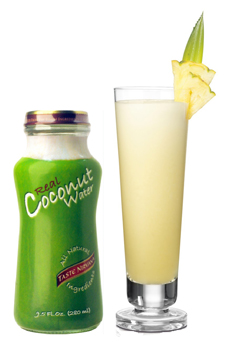TIP OF THE DAY: Lower Calorie Piña Colada
|
In our youth, we used to have an annual “Tropical Winter” party on Valentine’s Day. It was for everyone who had nothing else to do, those who disliked Valentine’s Day and anyone who simply liked a good Piña Colada.
Piña Coladas were the drink of the evening. The fare was tropical-inspired, from fruit skewers and chicken skewers to rumaki*, a broiled, bacon-wrapped chicken liver and water chestnut hors d’oeuvre that was all the rage at the time. Coconut water was years from appearing in American markets. If only Tropical Winter had lasted until it arrived, we’d have offered a Piña Colada Lite, substituting very-low-calorie coconut water (6 calories/ounce, or 12 calories per drink) for very-high-calorie Coco López (130 calories/ounce, or 260 calories per drink; plain coconut milk is 65 calories/ounce). |
 Go light with coconut water instead of Coco López. Photo courtesy TasteNirvana.com. |
|
|
Piña Coladas are delicious, but they sure pack in the sugar and saturated fat. Here’s a “drink this, not that” tip from coconut water brand Taste Nirvana, on how to lower your Piña Colada calories while still enjoying a taste of the tropics and natural coconut flavor. CLASSIC PINA COLADA RECIPE Ingredients Per Drink 1. MIX ingredients in blender until smooth. Pour into a tall glass. 2. GARNISH and serve. WHAT’S COCO LÓPEZ? Coco López is a brand of cream of coconut, invented in 1954by Ramón López Irizarry, a professor of agriculture at the University of Puerto Rico. The ingredients on the can include coconut milk, sugar, water, emulsifiers, stabilizers and thickeners (guar gum, locust bean gum, mono- and diglycerides, polysorb 60, sorbitan monostearate, Propylene glycol alginate) and preservative (citric acid). The creamy heart of the coconut had long been used in Caribbean desserts. But separating it from from the coconut pulp was an arduous process. With funds from the government, Irizarry worked on a solution. He ulimately left teaching to produce and sell his product, which was adopted not just by cooks but by bartenders. According to the book “La Gran Cocina Del Caribe” by José L. Díaz de Villega, the Piña Colada made its debut on August 16, 1954 at the Caribe Hilton’s Beachcomber Bar in San Juan, Puerto Rico, a watering hole for a star-studded clientele. The hotel management had requested that bartender Ramón “Monchito” Marrero create a new signature cocktail. Marrero worked for three months on the recipe. Piña is Spanish for pineapple, and colada means strained; the drink is usually served blended with ice. The Piña Colada has been the official beverage of Puerto Rico since 1978.
|
||


